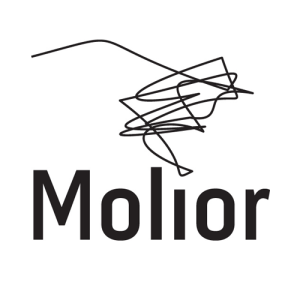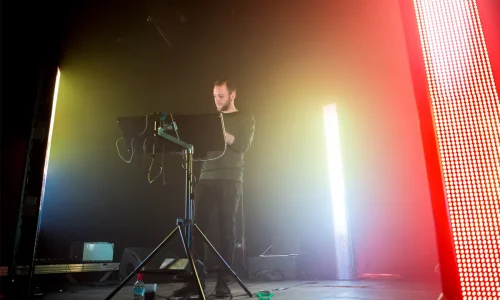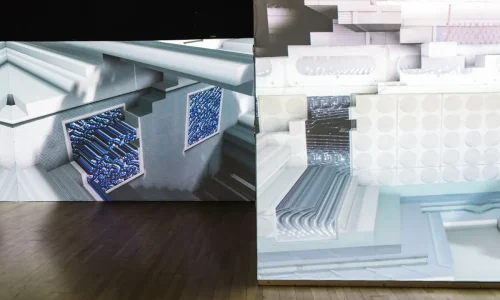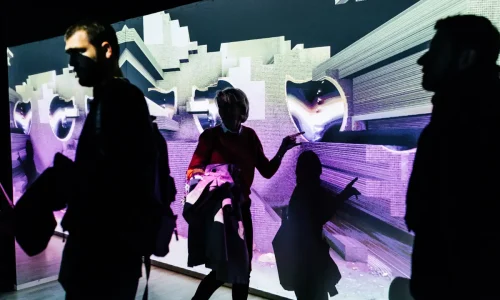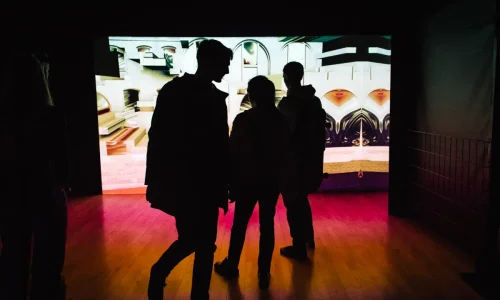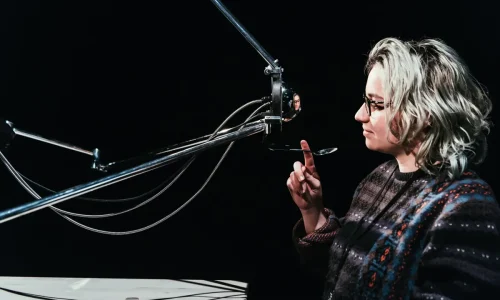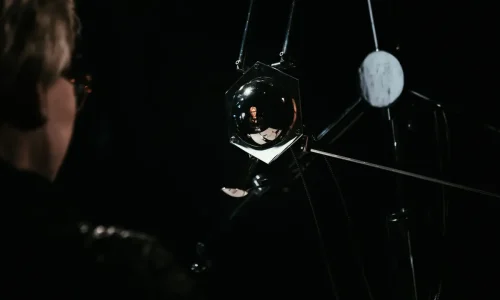Mirage Festival
Lyon, France
From April 4th to April 8th, 2018
Molior and Mirage Festival are joining forces for a first collaboration through the presentation of 3 digital works by 4 artists from Québec. They are coproducing a new work by Sabrina Ratté Machine for Living, which will be shown for the first time in installation form. Through its composition of 5 large video projections and mirrors, it unfolds as a truly immersive architectural structure made up of labyrinthine paths.
Molior and Mirage will also exhibit the robotic and interactive installation by Simon Laroche and David Szanto Orchestrer la perte / Perpetual Demotion and present the performance by Lucas Paris AntiVolume IN/EXT.
This year, Mirage festival is focusing on works that articulate multiple spatial dimensions and draw the viewer into unusual sensorial spaces in order to make them experience other realities. They stimulate the public’s engagement by offering it experiences of a fictional, dreamy or a virtual order.
The selection of works developed by Mirage Festival and Molior took four specific thematic main lines into account to approach the experience of other realities: The first refers to the relation of real/virtual/actual architecture spaces; the second to man/machine interactions; the third, to the experience of a synesthetic environment.
Sabrina Ratté made her videos during a residency at Château Éphémère in Carrière-sous-Poissy. She created architectures by drawing inspiration from the large housing projects of the Parisian suburbs and new cities such as Noisy-le-Grand, Créteil, la Grande Borne, la Défense and Cergy-Pontoise. The videos are animated by textures, colours and forms whose aesthetic is reminiscent of technologies from other periods, such as video synthesizers, mixers and visual feedbacks. “The aesthetic of the new cities is transformed, manipulated and deconstructed to be reborn in the form of environments that are at once abstract and recognizable, surreal but evocative of a certain known reality.(1)” The video projections that partition and arrange the exhibition space, form walls and a path to bypass them that viewers can move through.
The sound dimension created by Roger Tellier Craig is comprised of five tracks, each of which is assigned to a video and localized. The listening experience of the sound entity made up of these tracks varies according to the viewer’s position.
Mirrors mounted on each side of the screens echo the images and thus extend them. The doubling by the mirrors and some formal iterations in the 5 videos produce a repetitive effect similar to the collective housing units and blur the boundaries of the experienced space.
The multiplicity of the spaces’ dimensions reappears in the image, through the referenced architectural structures and the recognizable elements and textures that appear to be digital or derived from a recording of the real. The installation highlights this effect in the correspondences between the multiple videos and by the uncertain demarcations of the actual space.
Orchestrer la perte / Perpetual Demotion, a robotic installation, feeds the humans that stand in front of it. Its robotic arm descends to pick up a spoon. An edible paste is placed on it. The arm unbends and then moves towards the mouth of the viewer, who can decide to accept the mouthful and ingest it. The machine then returns the spoon to its slave, a human by its side, who assists it by then removing the used spoon.
The installation requires the physical participation of the viewer, who must coordinate his or her body with the robot and thus calls on the sense of sight, proprioception and, lastly, taste. The aesthetic experience extends into the viewers’ inner body space, since they must consent to being fed and ingesting the food paste.
The work plays on the trust the viewer is willing to place in the artist, on the one hand, and on the other in the machine, in a complex context that has the power of persuading them. It stages the take over, by way of an automated robotic and intrusive apparatus, of an everyday activity, “to eat.” By extension, this stimulates reflection about the development and implication in our societies of artificial intelligence systems or robots, who are increasingly managing our lives, from the most intimate arena to the broad social sphere. The work revisits the relationship of the dominant and dominated between the human and machine in “a context of technological determination orchestrating a generalized loss of control.(2)”
These power relations thus reappear on many levels and are multi-directional, not only in technology’s relationship to human beings but also to microbes. Some of the fermented ingredients are mixed and brought into interaction with other pasteurised ones. “The work opens a compelling perspective on the systemic and performative aspects of food (3)” and examines food-related biological, economic and socio-cultural issues.” The work’s presentation in the capital of French gastronomy further underscores this aspect and is certain to spark a discussion about the place of food as a territorial reference and indicator of particular behaviours. It confronts viewers with their own cultural representation of food, whether in reference to their experience, memory or emotion. Since our food defines us: what we eat defines who we are and who we are not (4), it puts the public in a situation that triggers an encounter with the other and other realities.
During the performance AntiVolume IN/EXT, Lucas Paris develops a live and at time improvised composition using both sound and light that immerses the viewer in a meditative state. Three LED columns are placed on the stage where they modulate the space according to their light variations. The artist draws inspiration from electronic musical forms such as noise, electronica and ambient music. He views his project as a “volatile and energetic sculpture (5)” the intensity of which he varies between granular effects and encompassing layers. The work instils a “physical and textural (6)” experience. The experience immerses and captivates the public in an aural and visual, but also proprioceptive synaesthesia, i.e. a similarity and translation between the stimuli inputs of the sound and light, as well as the sensations proper to one’s body. The whole of the performance transports the public into its intangible environment, while the light and sound penetrate and circulate through the entire body.
Aurélie Besson
MIRAGE FESTIVAL
The Mirage Festival has been exploring the diversity of digital cultures for six years. It invites the general public to discover the plurality of these cultures and acts as a catalyzer for an entire ecosystem of players in the artistic, cultural or creative industry sector.
The first event dedicated to digital cultures in Lyon, the Mirage Festival has succeeded in making itself an important player in Lyon’s vast cultural events offer by proposing a multidisciplinary, ambitious, groundbreaking and adventurous programming that provides a glimpse of what lies on the creative horizon.
The exhibition captivated the Lyon public and enthusiasts of visual, sound, graphic, kinetic and interactive experiences. The live evenings, a mix of concerts and performances, highlighted emerging projects alongside internationally renowned artists. The event’s specificity also emerged in relation to its reflective component: conferences, panel discussions, and project presentations completed its general pubic offer and made it a unifying gathering for all the players of the city’s digital creative scene. This constantly evolving scene can finally boast of an event that is agile enough to represent it and able to seize the major trends at the heart of the dialogue between 3.0 tech companies, researchers and artists.
Far from being a simple technical demonstration to the glory of the digital, the festival distinguished itself by casting a sharp eye on the links between artistic creation and technology. A recognized expertise that has led the festival to intervene on the national stage and beyond (Seoul, Bogota, Athens, Amsterdam, Belgrade etc.).
In acting on viewers’ spatial and sometimes sensorial dimensions, but above all by stimulating the power of their imagination, the works shown as part of the exhibition invite the public to “experiment with other realities,” whether they be virtual, sensorial or parallel! In creating set-ups designed for experimentation, the artists physically involve viewers, who are placed in a fictional, dreamy, virtual world that modifies their environment and appeals to their senses. The artists thus seek to change our relationship to the real and bring forth new realities with undefined borders and indistinct contours. Consequently, there is no longer a single and unique reality, but several realities.
This project has received support from the Conseil des arts et des lettres du Québec. Molior would like to thank its partner Mirage festival, the Canada Council for the Arts and the Conseil des arts de Montréal and the Délégation générale du Québec à Paris for their invaluable collaboration.
Artistes et oeuvres
Lucas Paris
Description of the work
AntiVolume is an immersion in a synesthetic space of timbre and colour. This version, IN/EXT, explores movements and dynamics between interior and exterior. In this series of performances, the audience is in the presence of a volatile and energetic sculpture, made of sound and light. Resulting from an algorithmic research, it is sculpted in real-time by the artist’s improvisation. Three columns of light occupy the performance space. The audience is immersed in this work and perceives it as a physical and textural experience. This work is in constant evolution. In part improvised, each performance is unique and reflects the venue and the audience. Lucas Paris draws inspiration from the vast vocabulary of electronic music: noise, ambient, IDM, EDM… These references are reinterpreted through a strong musical character and personal fantasy.
Thanks to Perte de Signal, Eastern Bloc, Maxime Damecour and Pipo Pierre-Louis.
Biography
An emerging artist in digital arts and electronic music, Paris has built digital instruments for more then 10 years in the pursuit of sculpting and engineering intangible sound and light in real-time. Pairing a deeply considered and expressive artistic approach with high-tech digital synthesis networks and modular instrument design, Lucas Paris creates multi-sensory, immersive and emotional new forms of audiovisual performance.
As a member of the Quadr and Betafeed projects, and with his personal projects Antivolume and Array, he performed at MUTEK MTL 2017/2016/MX 2017 and MUTEK ISEA Vancouver 2015, Akousma 2016, the BIAN 2014 and 2016, and at the TIES 2015. He carried out a residency at Eastern Bloc Montreal in January 2015, at VYV corporation in January 2018, has been an invited artist in residency at Concordia University’s Milieux Institute since September 2017, and is a member of the Perte de Signal artist-run centre. He studied digital music and digital instrument making at Université de Montréal.
Sabrina Ratté
Description of the work
Machine for Living is a project developed in the context of a nine-month residency at Château Ephémère (Carrière-sous-Poissy, France). The video series explores the architecture of new cities (Villes nouvelles) and Brutalist housing units in the Paris suburbs. Cities such as Noisy-le-Grand, Montigny-le-Bretonneux, Créteil, Grigny, Cergy-Pontoise, Nanterre and Ivry-sur-Seine were at the centre of this research. Created using photographs, 3D animation and video synthesizers, Machine for Living combines documentation and abstraction and straddles the line between utopia and dystopia.
Soundtrack by Roger Tellier Craig
Grant from the Canada Council for the Arts (International Residencies)
A project carried over the course of a residency at Château Éphémère, Carrière-sous-Poissy.
Coproduced by Mirage Festival and Molior.
Biography
Sabrina Ratté splits her time between Montreal and Paris. After a BFA and MFA in Film Production at Concordia University in Montreal, she focused mainly on video as a medium.
Her interest in early video art led her to work with analog technologies such as video synthesizers and video feedback. Later on, she integrated 3D animation to her process, which allowed for more complex imagery while creating a timeless aesthetic.
From utopian architecture to painterly textures, she explores the fine line between the virtual and the physical realms.
Her work includes single-channel videos, installations, sculptures, live performances and prints. Previous exhibitions: Material Art Fair (Mexico), Dolby Gallery (San Francisco), Young Project Gallery (Los Angeles), Whitney Museum of Art (NYC), Variation Media Art Fair (Paris), Chronus Art Center, (Shanghai), Paddles On! 1st Digital Art Auction at Phillips (New York), HEK (Basel), EMPAC (Troy), Museum of the Moving Image (New York), International Digital Art Biennal -Bian (Montreal), PHI Center (Montreal), Arsenal (Mtl), the Lampo series (Chicago), Atonal Festival (Berlin), Elektra, MUTEK (Mtl, Mexico, Barcelona). She is represented by Laffy Maffei Gallery in Paris and by Ellephant Gallery in Montreal.
Simon Laroche & David Szanto
Description of the work
A machine feeds its humans. Stardust or cyborg, substrate or bloom, social or technical, all things feed and are fed. Eating actions perpetuate patterns of nurturing and disempowerment, of growth, death, and decay. In repeated and reciprocal gestures, matter is cycled from one state to another: human, food, machine, food. Humans chew, swallow, and process, spawning energies and powering the machine. Microbes rearrange and stabilize tissue, neither raw nor cooked, fodder for the machine. Machines sustain their litter, feeding and desingularizing the human. In these cycles, bodies gain just as they lose control, eating, determining, and orchestrating their own demotions.
Probing these relationships of influence and dependence that link humans and technology, Orchestrer la perte/Perpetual Demotion is an interactive robotic installation comprising a feeding robot, edible food pastes, a refrigerator, and a human “slave.” By enslaving the human to the robot, and by incorporating both fermented and industrially stabilized foods, the work provides a perspective on the systemic and performative aspects of eating. By extension, it also invites reflection on the economic, political, and ecological implications of human activity.
Biography
Artist, teacher, and interaction designer, Simon Laroche creates installations, audio and video performances, robotic and body artworks. He casts a critical point of view on the hybridization and development of various biological, artificial, and social systems. Co-founder of the art collective, Projet EVA, he creates critical, experimental, and transgressive artworks that focus on problematics related to relationships between individuals, computer systems, and their physical extensions. Simon Laroche teaches Electronic Arts at Concordia University in Montreal and collaborates on theatre, fashion design, dance, and cinema productions. His installations, performances and collaborative works have been presented in Asia, Europe, South and North America and in the Middle East.
David Szanto is a researcher, artist, and writer, who takes an experimental approach to gastronomy through design, ecology, and performance. Past projects include: The ‘Main’ Dish and A Tranche of Berlin, meal performances focusing on the representation of urban foodscapes; Displace (Mediations of Sensation), an immersive sensory environment; and The Gastronome in You, a performance-installation treating the continuity of human life through memory, bread, and the microbiome. He has taught food studies at Concordia University and l’Université du Québec à Montréal, and gastronomy and communications at the University of Gastronomic Sciences in Italy. David has written numerous articles and book chapters on food, art, and performance, and he is a regular contributor to the magazine Montréal enSanté.
